Introduction to HRM and Talent Development: Key Concepts and Practices
VerifiedAdded on 2023/01/13
|12
|3941
|100
Essay
AI Summary
This essay provides an overview of Human Resource Management (HRM) and Talent Development, addressing key concepts such as absence management, recruitment and selection processes, and motivation theories within the workplace. The essay begins by highlighting the importance of proactively managing employee absence, discussing the types and reasons for absenteeism, and outlining methods for controlling high absence rates through procedural documents and motivational approaches. It then delves into recruitment and selection procedures, using Tesco as a case study, evaluating both internal and external recruitment sources and the various selection methods, including interviews and employment tests. Finally, the essay explores three motivation process theories and their application in the workplace, emphasizing their role in encouraging employees to achieve organizational goals and improve performance. The essay aims to provide a comprehensive understanding of the interplay between these HRM elements and their impact on organizational success.
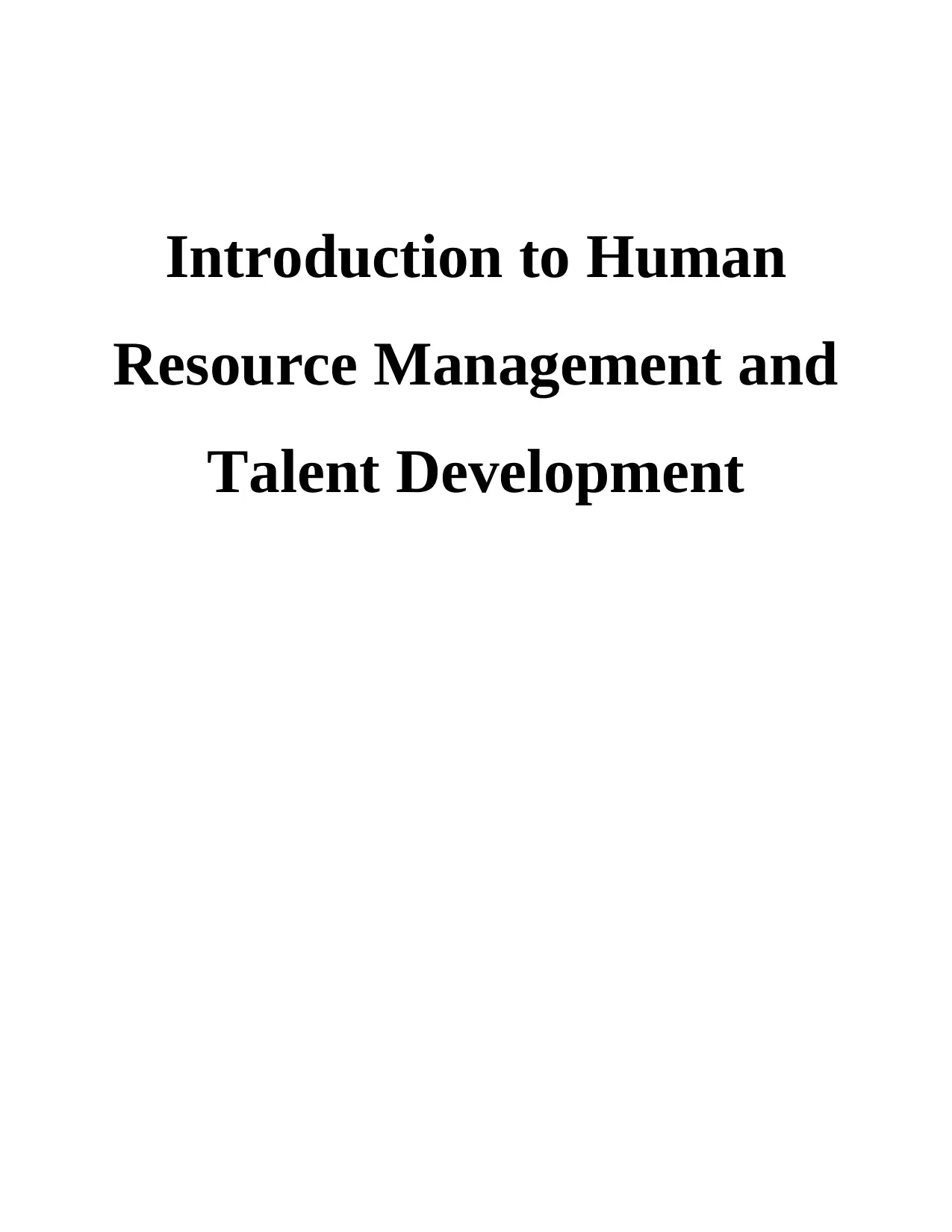
Introduction to Human
Resource Management and
Talent Development
Resource Management and
Talent Development
Paraphrase This Document
Need a fresh take? Get an instant paraphrase of this document with our AI Paraphraser
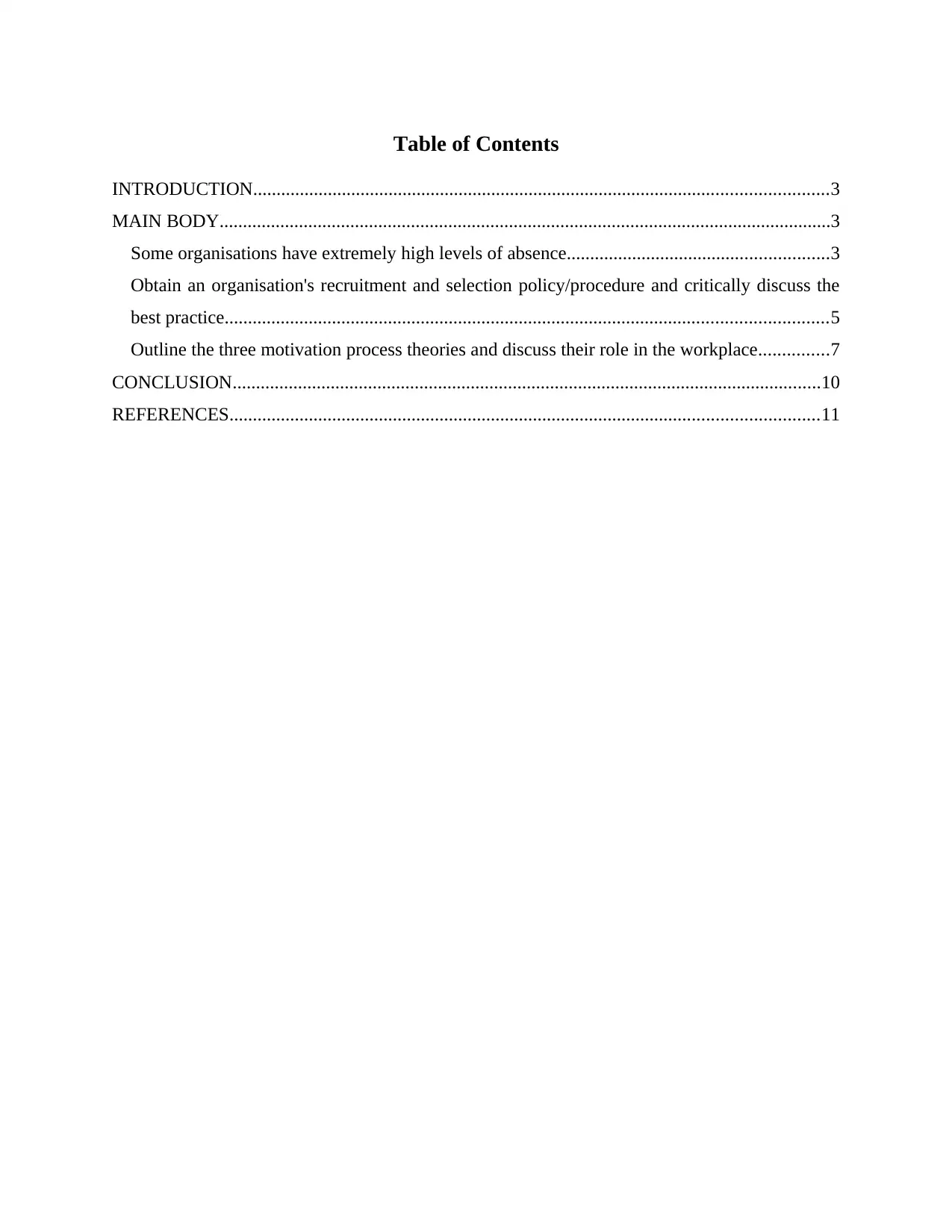
Table of Contents
INTRODUCTION...........................................................................................................................3
MAIN BODY...................................................................................................................................3
Some organisations have extremely high levels of absence........................................................3
Obtain an organisation's recruitment and selection policy/procedure and critically discuss the
best practice.................................................................................................................................5
Outline the three motivation process theories and discuss their role in the workplace...............7
CONCLUSION..............................................................................................................................10
REFERENCES..............................................................................................................................11
INTRODUCTION...........................................................................................................................3
MAIN BODY...................................................................................................................................3
Some organisations have extremely high levels of absence........................................................3
Obtain an organisation's recruitment and selection policy/procedure and critically discuss the
best practice.................................................................................................................................5
Outline the three motivation process theories and discuss their role in the workplace...............7
CONCLUSION..............................................................................................................................10
REFERENCES..............................................................................................................................11
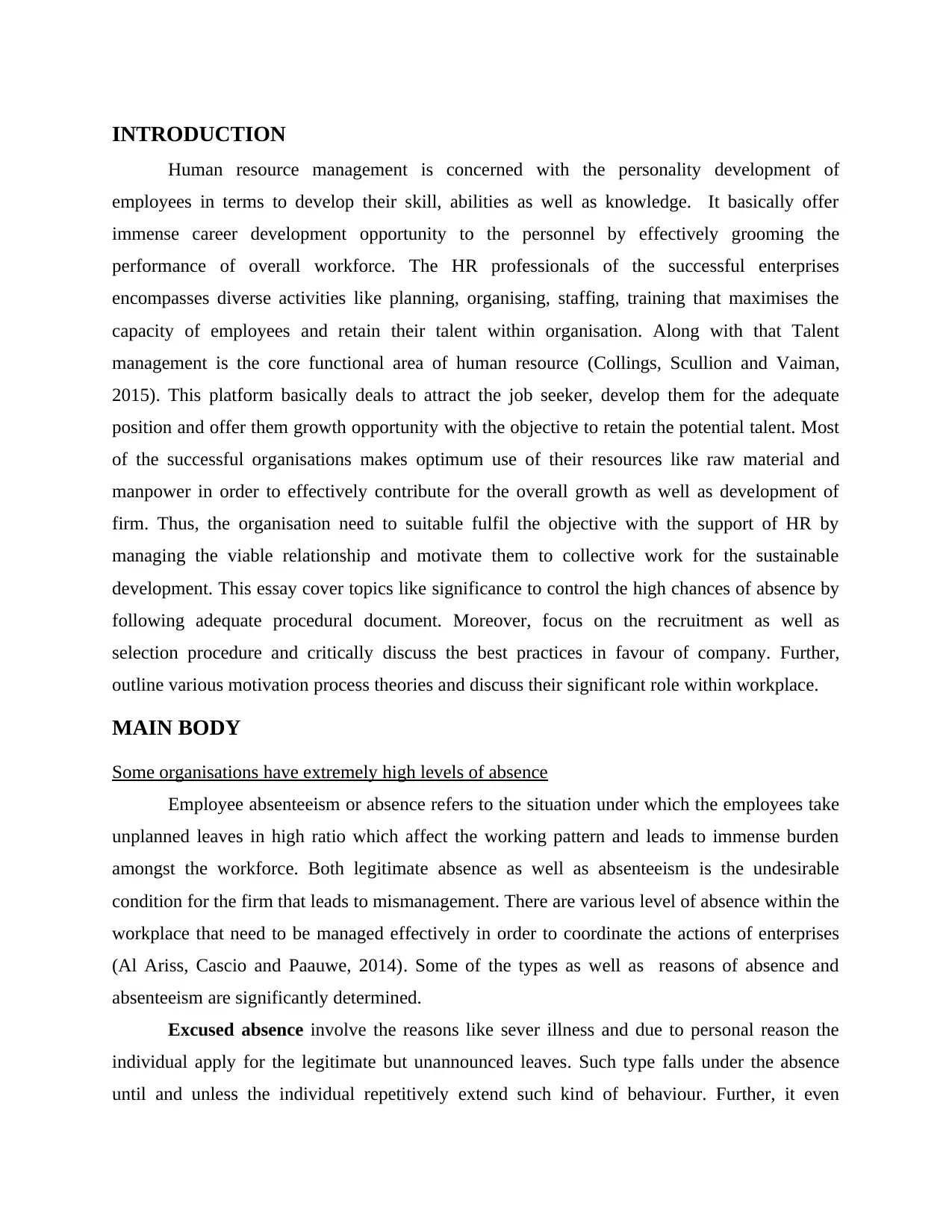
INTRODUCTION
Human resource management is concerned with the personality development of
employees in terms to develop their skill, abilities as well as knowledge. It basically offer
immense career development opportunity to the personnel by effectively grooming the
performance of overall workforce. The HR professionals of the successful enterprises
encompasses diverse activities like planning, organising, staffing, training that maximises the
capacity of employees and retain their talent within organisation. Along with that Talent
management is the core functional area of human resource (Collings, Scullion and Vaiman,
2015). This platform basically deals to attract the job seeker, develop them for the adequate
position and offer them growth opportunity with the objective to retain the potential talent. Most
of the successful organisations makes optimum use of their resources like raw material and
manpower in order to effectively contribute for the overall growth as well as development of
firm. Thus, the organisation need to suitable fulfil the objective with the support of HR by
managing the viable relationship and motivate them to collective work for the sustainable
development. This essay cover topics like significance to control the high chances of absence by
following adequate procedural document. Moreover, focus on the recruitment as well as
selection procedure and critically discuss the best practices in favour of company. Further,
outline various motivation process theories and discuss their significant role within workplace.
MAIN BODY
Some organisations have extremely high levels of absence
Employee absenteeism or absence refers to the situation under which the employees take
unplanned leaves in high ratio which affect the working pattern and leads to immense burden
amongst the workforce. Both legitimate absence as well as absenteeism is the undesirable
condition for the firm that leads to mismanagement. There are various level of absence within the
workplace that need to be managed effectively in order to coordinate the actions of enterprises
(Al Ariss, Cascio and Paauwe, 2014). Some of the types as well as reasons of absence and
absenteeism are significantly determined.
Excused absence involve the reasons like sever illness and due to personal reason the
individual apply for the legitimate but unannounced leaves. Such type falls under the absence
until and unless the individual repetitively extend such kind of behaviour. Further, it even
Human resource management is concerned with the personality development of
employees in terms to develop their skill, abilities as well as knowledge. It basically offer
immense career development opportunity to the personnel by effectively grooming the
performance of overall workforce. The HR professionals of the successful enterprises
encompasses diverse activities like planning, organising, staffing, training that maximises the
capacity of employees and retain their talent within organisation. Along with that Talent
management is the core functional area of human resource (Collings, Scullion and Vaiman,
2015). This platform basically deals to attract the job seeker, develop them for the adequate
position and offer them growth opportunity with the objective to retain the potential talent. Most
of the successful organisations makes optimum use of their resources like raw material and
manpower in order to effectively contribute for the overall growth as well as development of
firm. Thus, the organisation need to suitable fulfil the objective with the support of HR by
managing the viable relationship and motivate them to collective work for the sustainable
development. This essay cover topics like significance to control the high chances of absence by
following adequate procedural document. Moreover, focus on the recruitment as well as
selection procedure and critically discuss the best practices in favour of company. Further,
outline various motivation process theories and discuss their significant role within workplace.
MAIN BODY
Some organisations have extremely high levels of absence
Employee absenteeism or absence refers to the situation under which the employees take
unplanned leaves in high ratio which affect the working pattern and leads to immense burden
amongst the workforce. Both legitimate absence as well as absenteeism is the undesirable
condition for the firm that leads to mismanagement. There are various level of absence within the
workplace that need to be managed effectively in order to coordinate the actions of enterprises
(Al Ariss, Cascio and Paauwe, 2014). Some of the types as well as reasons of absence and
absenteeism are significantly determined.
Excused absence involve the reasons like sever illness and due to personal reason the
individual apply for the legitimate but unannounced leaves. Such type falls under the absence
until and unless the individual repetitively extend such kind of behaviour. Further, it even
⊘ This is a preview!⊘
Do you want full access?
Subscribe today to unlock all pages.

Trusted by 1+ million students worldwide
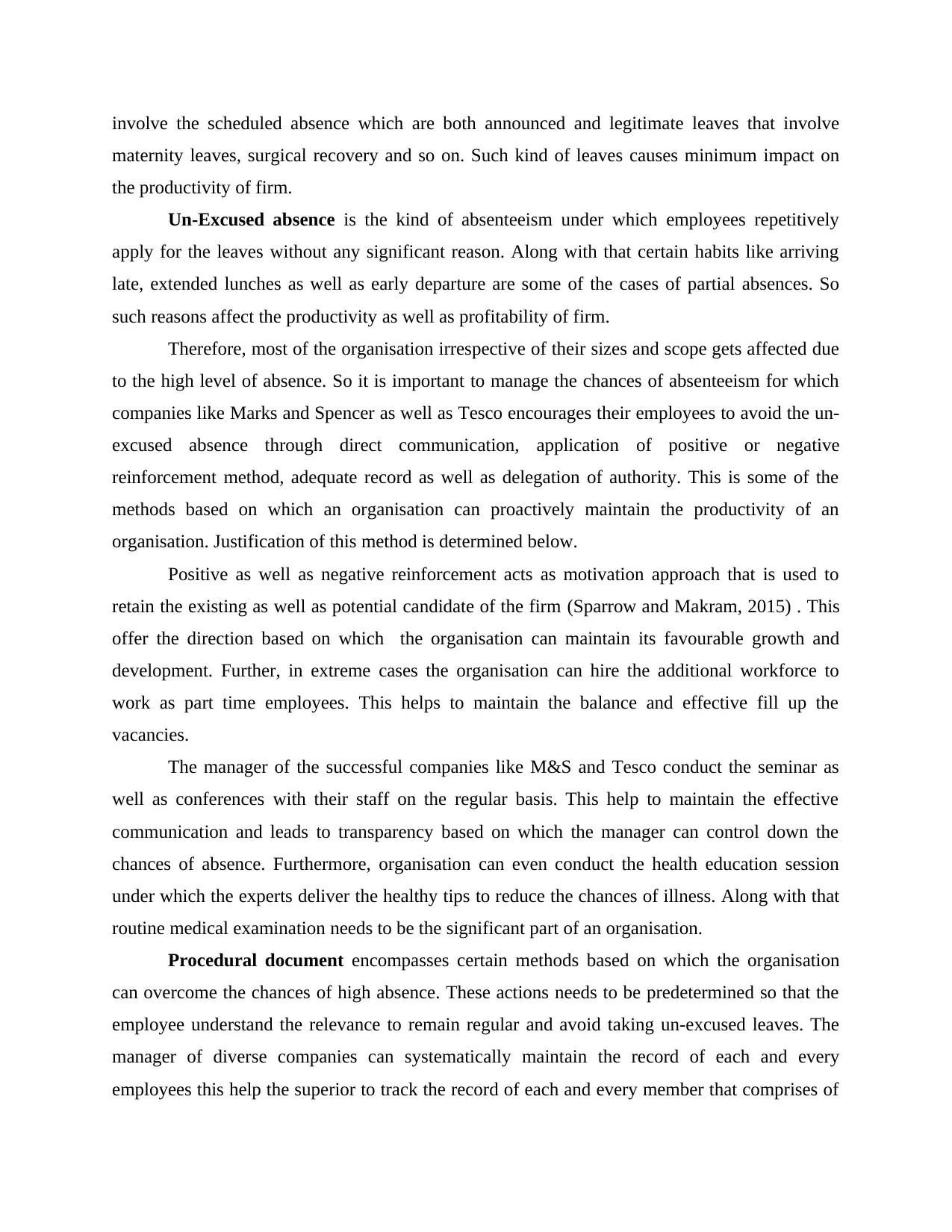
involve the scheduled absence which are both announced and legitimate leaves that involve
maternity leaves, surgical recovery and so on. Such kind of leaves causes minimum impact on
the productivity of firm.
Un-Excused absence is the kind of absenteeism under which employees repetitively
apply for the leaves without any significant reason. Along with that certain habits like arriving
late, extended lunches as well as early departure are some of the cases of partial absences. So
such reasons affect the productivity as well as profitability of firm.
Therefore, most of the organisation irrespective of their sizes and scope gets affected due
to the high level of absence. So it is important to manage the chances of absenteeism for which
companies like Marks and Spencer as well as Tesco encourages their employees to avoid the un-
excused absence through direct communication, application of positive or negative
reinforcement method, adequate record as well as delegation of authority. This is some of the
methods based on which an organisation can proactively maintain the productivity of an
organisation. Justification of this method is determined below.
Positive as well as negative reinforcement acts as motivation approach that is used to
retain the existing as well as potential candidate of the firm (Sparrow and Makram, 2015) . This
offer the direction based on which the organisation can maintain its favourable growth and
development. Further, in extreme cases the organisation can hire the additional workforce to
work as part time employees. This helps to maintain the balance and effective fill up the
vacancies.
The manager of the successful companies like M&S and Tesco conduct the seminar as
well as conferences with their staff on the regular basis. This help to maintain the effective
communication and leads to transparency based on which the manager can control down the
chances of absence. Furthermore, organisation can even conduct the health education session
under which the experts deliver the healthy tips to reduce the chances of illness. Along with that
routine medical examination needs to be the significant part of an organisation.
Procedural document encompasses certain methods based on which the organisation
can overcome the chances of high absence. These actions needs to be predetermined so that the
employee understand the relevance to remain regular and avoid taking un-excused leaves. The
manager of diverse companies can systematically maintain the record of each and every
employees this help the superior to track the record of each and every member that comprises of
maternity leaves, surgical recovery and so on. Such kind of leaves causes minimum impact on
the productivity of firm.
Un-Excused absence is the kind of absenteeism under which employees repetitively
apply for the leaves without any significant reason. Along with that certain habits like arriving
late, extended lunches as well as early departure are some of the cases of partial absences. So
such reasons affect the productivity as well as profitability of firm.
Therefore, most of the organisation irrespective of their sizes and scope gets affected due
to the high level of absence. So it is important to manage the chances of absenteeism for which
companies like Marks and Spencer as well as Tesco encourages their employees to avoid the un-
excused absence through direct communication, application of positive or negative
reinforcement method, adequate record as well as delegation of authority. This is some of the
methods based on which an organisation can proactively maintain the productivity of an
organisation. Justification of this method is determined below.
Positive as well as negative reinforcement acts as motivation approach that is used to
retain the existing as well as potential candidate of the firm (Sparrow and Makram, 2015) . This
offer the direction based on which the organisation can maintain its favourable growth and
development. Further, in extreme cases the organisation can hire the additional workforce to
work as part time employees. This helps to maintain the balance and effective fill up the
vacancies.
The manager of the successful companies like M&S and Tesco conduct the seminar as
well as conferences with their staff on the regular basis. This help to maintain the effective
communication and leads to transparency based on which the manager can control down the
chances of absence. Furthermore, organisation can even conduct the health education session
under which the experts deliver the healthy tips to reduce the chances of illness. Along with that
routine medical examination needs to be the significant part of an organisation.
Procedural document encompasses certain methods based on which the organisation
can overcome the chances of high absence. These actions needs to be predetermined so that the
employee understand the relevance to remain regular and avoid taking un-excused leaves. The
manager of diverse companies can systematically maintain the record of each and every
employees this help the superior to track the record of each and every member that comprises of
Paraphrase This Document
Need a fresh take? Get an instant paraphrase of this document with our AI Paraphraser
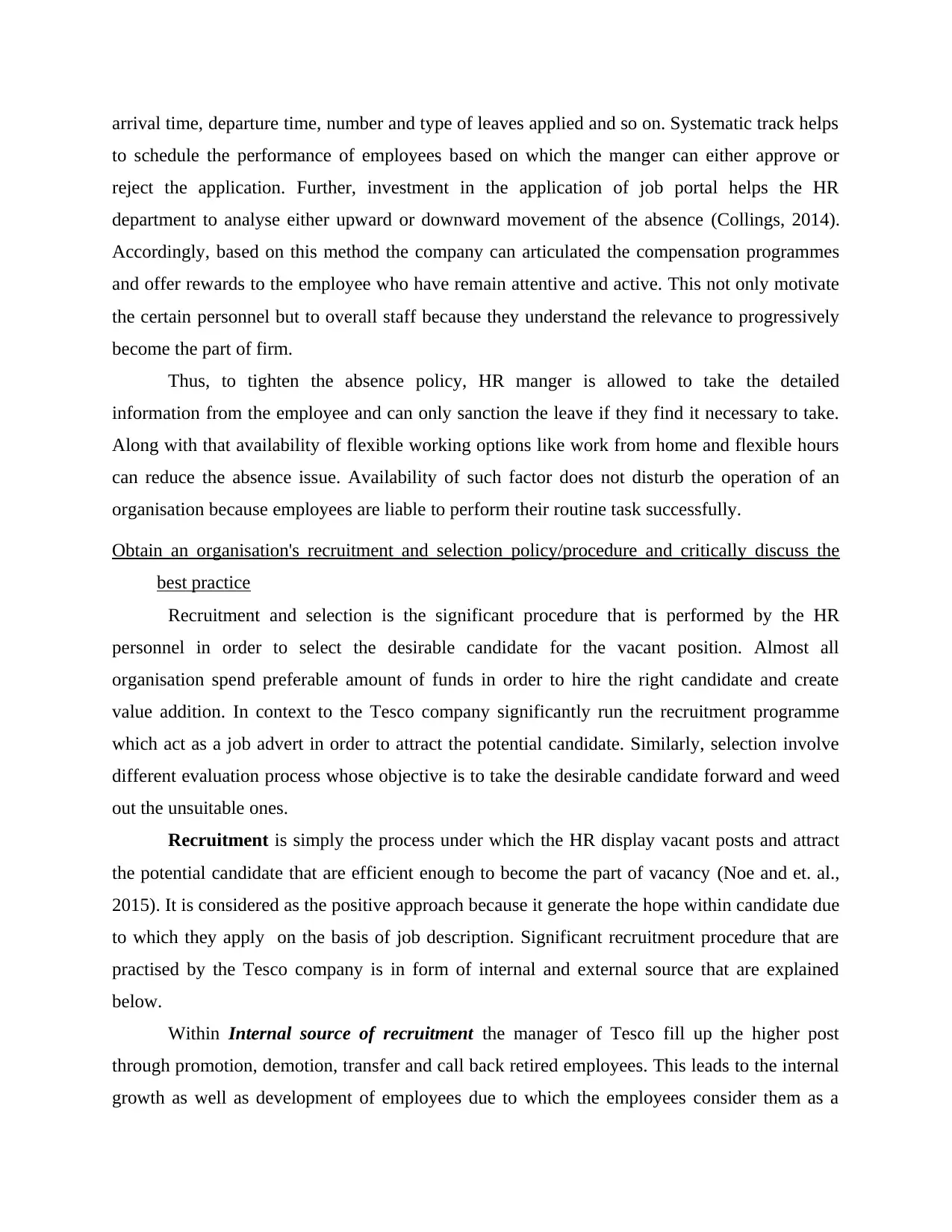
arrival time, departure time, number and type of leaves applied and so on. Systematic track helps
to schedule the performance of employees based on which the manger can either approve or
reject the application. Further, investment in the application of job portal helps the HR
department to analyse either upward or downward movement of the absence (Collings, 2014).
Accordingly, based on this method the company can articulated the compensation programmes
and offer rewards to the employee who have remain attentive and active. This not only motivate
the certain personnel but to overall staff because they understand the relevance to progressively
become the part of firm.
Thus, to tighten the absence policy, HR manger is allowed to take the detailed
information from the employee and can only sanction the leave if they find it necessary to take.
Along with that availability of flexible working options like work from home and flexible hours
can reduce the absence issue. Availability of such factor does not disturb the operation of an
organisation because employees are liable to perform their routine task successfully.
Obtain an organisation's recruitment and selection policy/procedure and critically discuss the
best practice
Recruitment and selection is the significant procedure that is performed by the HR
personnel in order to select the desirable candidate for the vacant position. Almost all
organisation spend preferable amount of funds in order to hire the right candidate and create
value addition. In context to the Tesco company significantly run the recruitment programme
which act as a job advert in order to attract the potential candidate. Similarly, selection involve
different evaluation process whose objective is to take the desirable candidate forward and weed
out the unsuitable ones.
Recruitment is simply the process under which the HR display vacant posts and attract
the potential candidate that are efficient enough to become the part of vacancy (Noe and et. al.,
2015). It is considered as the positive approach because it generate the hope within candidate due
to which they apply on the basis of job description. Significant recruitment procedure that are
practised by the Tesco company is in form of internal and external source that are explained
below.
Within Internal source of recruitment the manager of Tesco fill up the higher post
through promotion, demotion, transfer and call back retired employees. This leads to the internal
growth as well as development of employees due to which the employees consider them as a
to schedule the performance of employees based on which the manger can either approve or
reject the application. Further, investment in the application of job portal helps the HR
department to analyse either upward or downward movement of the absence (Collings, 2014).
Accordingly, based on this method the company can articulated the compensation programmes
and offer rewards to the employee who have remain attentive and active. This not only motivate
the certain personnel but to overall staff because they understand the relevance to progressively
become the part of firm.
Thus, to tighten the absence policy, HR manger is allowed to take the detailed
information from the employee and can only sanction the leave if they find it necessary to take.
Along with that availability of flexible working options like work from home and flexible hours
can reduce the absence issue. Availability of such factor does not disturb the operation of an
organisation because employees are liable to perform their routine task successfully.
Obtain an organisation's recruitment and selection policy/procedure and critically discuss the
best practice
Recruitment and selection is the significant procedure that is performed by the HR
personnel in order to select the desirable candidate for the vacant position. Almost all
organisation spend preferable amount of funds in order to hire the right candidate and create
value addition. In context to the Tesco company significantly run the recruitment programme
which act as a job advert in order to attract the potential candidate. Similarly, selection involve
different evaluation process whose objective is to take the desirable candidate forward and weed
out the unsuitable ones.
Recruitment is simply the process under which the HR display vacant posts and attract
the potential candidate that are efficient enough to become the part of vacancy (Noe and et. al.,
2015). It is considered as the positive approach because it generate the hope within candidate due
to which they apply on the basis of job description. Significant recruitment procedure that are
practised by the Tesco company is in form of internal and external source that are explained
below.
Within Internal source of recruitment the manager of Tesco fill up the higher post
through promotion, demotion, transfer and call back retired employees. This leads to the internal
growth as well as development of employees due to which the employees consider them as a
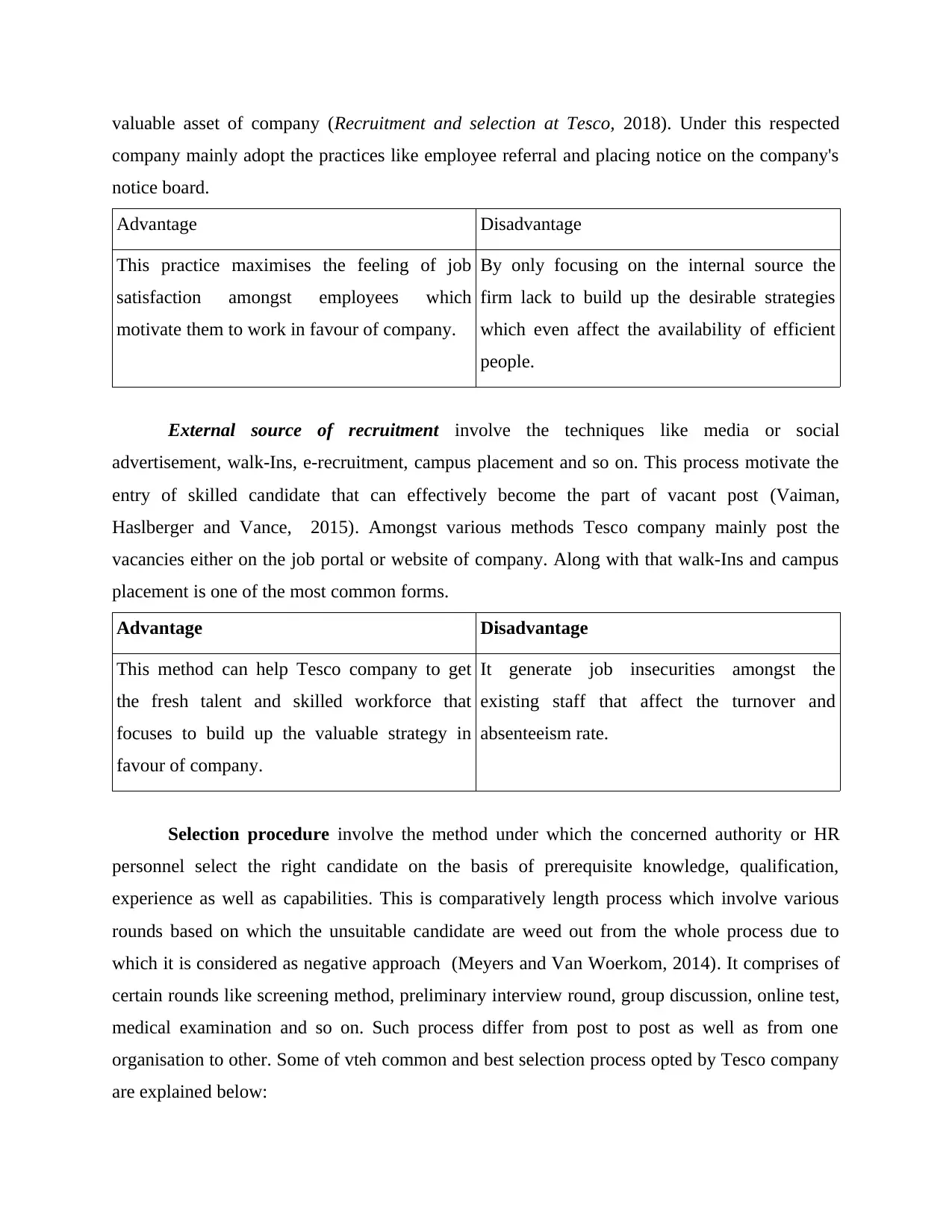
valuable asset of company (Recruitment and selection at Tesco, 2018). Under this respected
company mainly adopt the practices like employee referral and placing notice on the company's
notice board.
Advantage Disadvantage
This practice maximises the feeling of job
satisfaction amongst employees which
motivate them to work in favour of company.
By only focusing on the internal source the
firm lack to build up the desirable strategies
which even affect the availability of efficient
people.
External source of recruitment involve the techniques like media or social
advertisement, walk-Ins, e-recruitment, campus placement and so on. This process motivate the
entry of skilled candidate that can effectively become the part of vacant post (Vaiman,
Haslberger and Vance, 2015). Amongst various methods Tesco company mainly post the
vacancies either on the job portal or website of company. Along with that walk-Ins and campus
placement is one of the most common forms.
Advantage Disadvantage
This method can help Tesco company to get
the fresh talent and skilled workforce that
focuses to build up the valuable strategy in
favour of company.
It generate job insecurities amongst the
existing staff that affect the turnover and
absenteeism rate.
Selection procedure involve the method under which the concerned authority or HR
personnel select the right candidate on the basis of prerequisite knowledge, qualification,
experience as well as capabilities. This is comparatively length process which involve various
rounds based on which the unsuitable candidate are weed out from the whole process due to
which it is considered as negative approach (Meyers and Van Woerkom, 2014). It comprises of
certain rounds like screening method, preliminary interview round, group discussion, online test,
medical examination and so on. Such process differ from post to post as well as from one
organisation to other. Some of vteh common and best selection process opted by Tesco company
are explained below:
company mainly adopt the practices like employee referral and placing notice on the company's
notice board.
Advantage Disadvantage
This practice maximises the feeling of job
satisfaction amongst employees which
motivate them to work in favour of company.
By only focusing on the internal source the
firm lack to build up the desirable strategies
which even affect the availability of efficient
people.
External source of recruitment involve the techniques like media or social
advertisement, walk-Ins, e-recruitment, campus placement and so on. This process motivate the
entry of skilled candidate that can effectively become the part of vacant post (Vaiman,
Haslberger and Vance, 2015). Amongst various methods Tesco company mainly post the
vacancies either on the job portal or website of company. Along with that walk-Ins and campus
placement is one of the most common forms.
Advantage Disadvantage
This method can help Tesco company to get
the fresh talent and skilled workforce that
focuses to build up the valuable strategy in
favour of company.
It generate job insecurities amongst the
existing staff that affect the turnover and
absenteeism rate.
Selection procedure involve the method under which the concerned authority or HR
personnel select the right candidate on the basis of prerequisite knowledge, qualification,
experience as well as capabilities. This is comparatively length process which involve various
rounds based on which the unsuitable candidate are weed out from the whole process due to
which it is considered as negative approach (Meyers and Van Woerkom, 2014). It comprises of
certain rounds like screening method, preliminary interview round, group discussion, online test,
medical examination and so on. Such process differ from post to post as well as from one
organisation to other. Some of vteh common and best selection process opted by Tesco company
are explained below:
⊘ This is a preview!⊘
Do you want full access?
Subscribe today to unlock all pages.

Trusted by 1+ million students worldwide
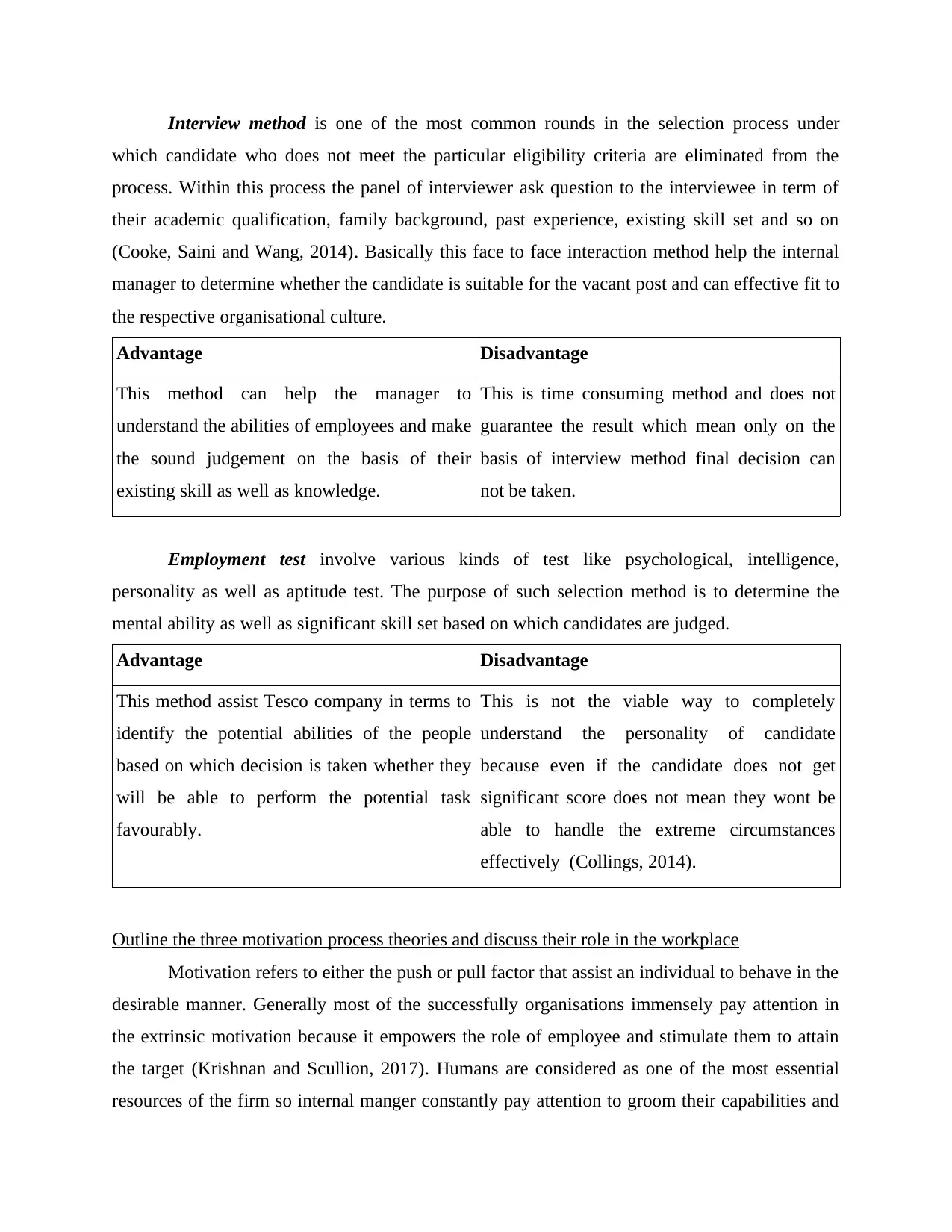
Interview method is one of the most common rounds in the selection process under
which candidate who does not meet the particular eligibility criteria are eliminated from the
process. Within this process the panel of interviewer ask question to the interviewee in term of
their academic qualification, family background, past experience, existing skill set and so on
(Cooke, Saini and Wang, 2014). Basically this face to face interaction method help the internal
manager to determine whether the candidate is suitable for the vacant post and can effective fit to
the respective organisational culture.
Advantage Disadvantage
This method can help the manager to
understand the abilities of employees and make
the sound judgement on the basis of their
existing skill as well as knowledge.
This is time consuming method and does not
guarantee the result which mean only on the
basis of interview method final decision can
not be taken.
Employment test involve various kinds of test like psychological, intelligence,
personality as well as aptitude test. The purpose of such selection method is to determine the
mental ability as well as significant skill set based on which candidates are judged.
Advantage Disadvantage
This method assist Tesco company in terms to
identify the potential abilities of the people
based on which decision is taken whether they
will be able to perform the potential task
favourably.
This is not the viable way to completely
understand the personality of candidate
because even if the candidate does not get
significant score does not mean they wont be
able to handle the extreme circumstances
effectively (Collings, 2014).
Outline the three motivation process theories and discuss their role in the workplace
Motivation refers to either the push or pull factor that assist an individual to behave in the
desirable manner. Generally most of the successfully organisations immensely pay attention in
the extrinsic motivation because it empowers the role of employee and stimulate them to attain
the target (Krishnan and Scullion, 2017). Humans are considered as one of the most essential
resources of the firm so internal manger constantly pay attention to groom their capabilities and
which candidate who does not meet the particular eligibility criteria are eliminated from the
process. Within this process the panel of interviewer ask question to the interviewee in term of
their academic qualification, family background, past experience, existing skill set and so on
(Cooke, Saini and Wang, 2014). Basically this face to face interaction method help the internal
manager to determine whether the candidate is suitable for the vacant post and can effective fit to
the respective organisational culture.
Advantage Disadvantage
This method can help the manager to
understand the abilities of employees and make
the sound judgement on the basis of their
existing skill as well as knowledge.
This is time consuming method and does not
guarantee the result which mean only on the
basis of interview method final decision can
not be taken.
Employment test involve various kinds of test like psychological, intelligence,
personality as well as aptitude test. The purpose of such selection method is to determine the
mental ability as well as significant skill set based on which candidates are judged.
Advantage Disadvantage
This method assist Tesco company in terms to
identify the potential abilities of the people
based on which decision is taken whether they
will be able to perform the potential task
favourably.
This is not the viable way to completely
understand the personality of candidate
because even if the candidate does not get
significant score does not mean they wont be
able to handle the extreme circumstances
effectively (Collings, 2014).
Outline the three motivation process theories and discuss their role in the workplace
Motivation refers to either the push or pull factor that assist an individual to behave in the
desirable manner. Generally most of the successfully organisations immensely pay attention in
the extrinsic motivation because it empowers the role of employee and stimulate them to attain
the target (Krishnan and Scullion, 2017). Humans are considered as one of the most essential
resources of the firm so internal manger constantly pay attention to groom their capabilities and
Paraphrase This Document
Need a fresh take? Get an instant paraphrase of this document with our AI Paraphraser
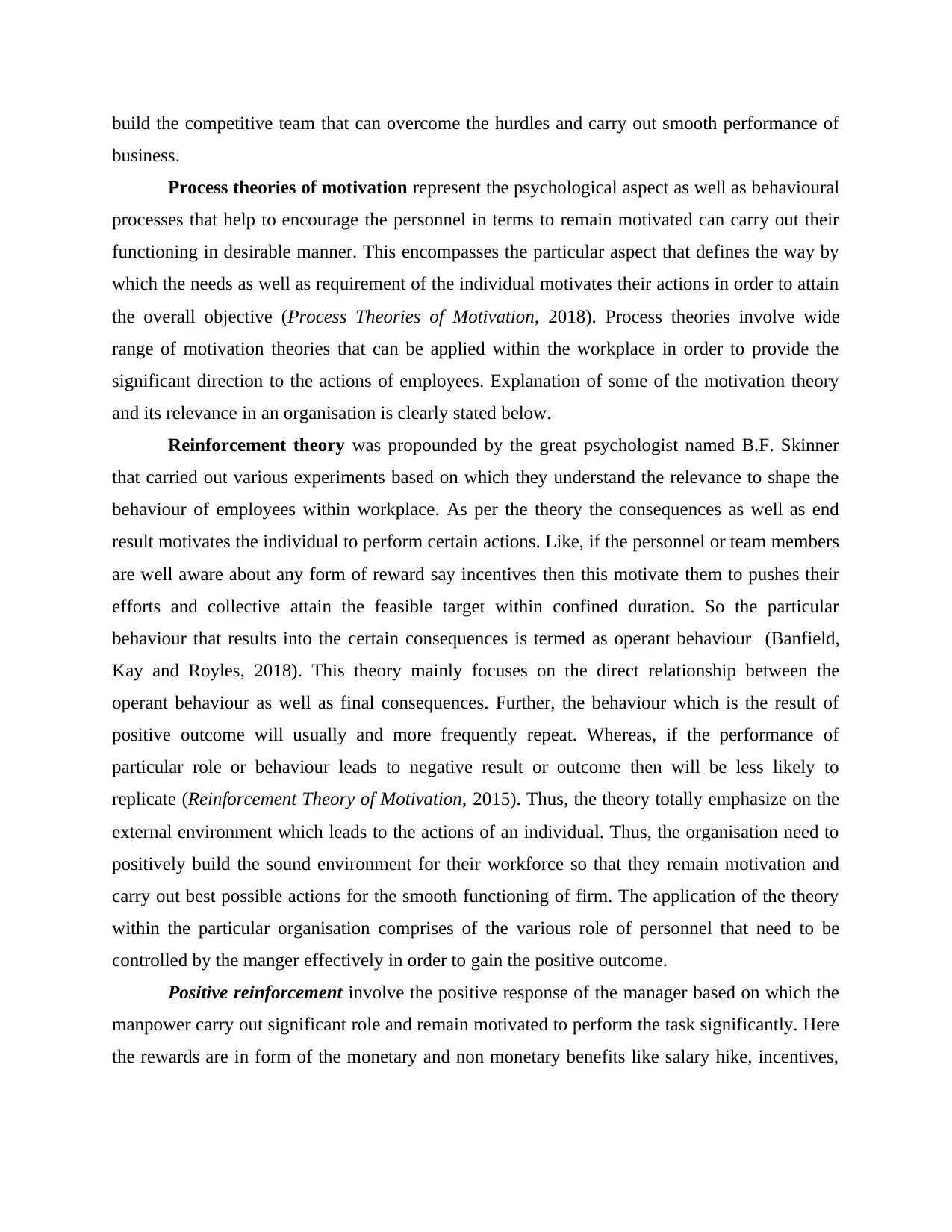
build the competitive team that can overcome the hurdles and carry out smooth performance of
business.
Process theories of motivation represent the psychological aspect as well as behavioural
processes that help to encourage the personnel in terms to remain motivated can carry out their
functioning in desirable manner. This encompasses the particular aspect that defines the way by
which the needs as well as requirement of the individual motivates their actions in order to attain
the overall objective (Process Theories of Motivation, 2018). Process theories involve wide
range of motivation theories that can be applied within the workplace in order to provide the
significant direction to the actions of employees. Explanation of some of the motivation theory
and its relevance in an organisation is clearly stated below.
Reinforcement theory was propounded by the great psychologist named B.F. Skinner
that carried out various experiments based on which they understand the relevance to shape the
behaviour of employees within workplace. As per the theory the consequences as well as end
result motivates the individual to perform certain actions. Like, if the personnel or team members
are well aware about any form of reward say incentives then this motivate them to pushes their
efforts and collective attain the feasible target within confined duration. So the particular
behaviour that results into the certain consequences is termed as operant behaviour (Banfield,
Kay and Royles, 2018). This theory mainly focuses on the direct relationship between the
operant behaviour as well as final consequences. Further, the behaviour which is the result of
positive outcome will usually and more frequently repeat. Whereas, if the performance of
particular role or behaviour leads to negative result or outcome then will be less likely to
replicate (Reinforcement Theory of Motivation, 2015). Thus, the theory totally emphasize on the
external environment which leads to the actions of an individual. Thus, the organisation need to
positively build the sound environment for their workforce so that they remain motivation and
carry out best possible actions for the smooth functioning of firm. The application of the theory
within the particular organisation comprises of the various role of personnel that need to be
controlled by the manger effectively in order to gain the positive outcome.
Positive reinforcement involve the positive response of the manager based on which the
manpower carry out significant role and remain motivated to perform the task significantly. Here
the rewards are in form of the monetary and non monetary benefits like salary hike, incentives,
business.
Process theories of motivation represent the psychological aspect as well as behavioural
processes that help to encourage the personnel in terms to remain motivated can carry out their
functioning in desirable manner. This encompasses the particular aspect that defines the way by
which the needs as well as requirement of the individual motivates their actions in order to attain
the overall objective (Process Theories of Motivation, 2018). Process theories involve wide
range of motivation theories that can be applied within the workplace in order to provide the
significant direction to the actions of employees. Explanation of some of the motivation theory
and its relevance in an organisation is clearly stated below.
Reinforcement theory was propounded by the great psychologist named B.F. Skinner
that carried out various experiments based on which they understand the relevance to shape the
behaviour of employees within workplace. As per the theory the consequences as well as end
result motivates the individual to perform certain actions. Like, if the personnel or team members
are well aware about any form of reward say incentives then this motivate them to pushes their
efforts and collective attain the feasible target within confined duration. So the particular
behaviour that results into the certain consequences is termed as operant behaviour (Banfield,
Kay and Royles, 2018). This theory mainly focuses on the direct relationship between the
operant behaviour as well as final consequences. Further, the behaviour which is the result of
positive outcome will usually and more frequently repeat. Whereas, if the performance of
particular role or behaviour leads to negative result or outcome then will be less likely to
replicate (Reinforcement Theory of Motivation, 2015). Thus, the theory totally emphasize on the
external environment which leads to the actions of an individual. Thus, the organisation need to
positively build the sound environment for their workforce so that they remain motivation and
carry out best possible actions for the smooth functioning of firm. The application of the theory
within the particular organisation comprises of the various role of personnel that need to be
controlled by the manger effectively in order to gain the positive outcome.
Positive reinforcement involve the positive response of the manager based on which the
manpower carry out significant role and remain motivated to perform the task significantly. Here
the rewards are in form of the monetary and non monetary benefits like salary hike, incentives,
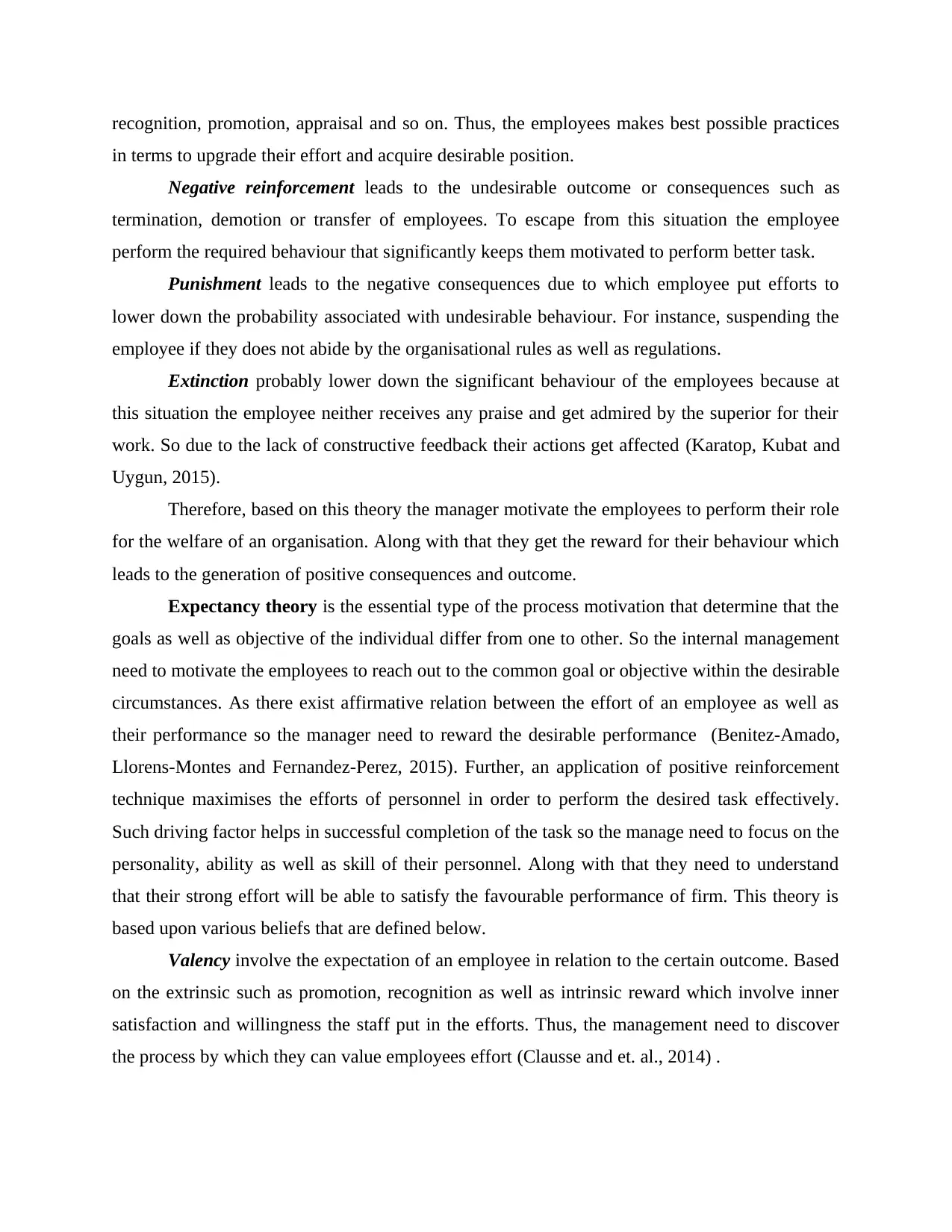
recognition, promotion, appraisal and so on. Thus, the employees makes best possible practices
in terms to upgrade their effort and acquire desirable position.
Negative reinforcement leads to the undesirable outcome or consequences such as
termination, demotion or transfer of employees. To escape from this situation the employee
perform the required behaviour that significantly keeps them motivated to perform better task.
Punishment leads to the negative consequences due to which employee put efforts to
lower down the probability associated with undesirable behaviour. For instance, suspending the
employee if they does not abide by the organisational rules as well as regulations.
Extinction probably lower down the significant behaviour of the employees because at
this situation the employee neither receives any praise and get admired by the superior for their
work. So due to the lack of constructive feedback their actions get affected (Karatop, Kubat and
Uygun, 2015).
Therefore, based on this theory the manager motivate the employees to perform their role
for the welfare of an organisation. Along with that they get the reward for their behaviour which
leads to the generation of positive consequences and outcome.
Expectancy theory is the essential type of the process motivation that determine that the
goals as well as objective of the individual differ from one to other. So the internal management
need to motivate the employees to reach out to the common goal or objective within the desirable
circumstances. As there exist affirmative relation between the effort of an employee as well as
their performance so the manager need to reward the desirable performance (Benitez-Amado,
Llorens-Montes and Fernandez-Perez, 2015). Further, an application of positive reinforcement
technique maximises the efforts of personnel in order to perform the desired task effectively.
Such driving factor helps in successful completion of the task so the manage need to focus on the
personality, ability as well as skill of their personnel. Along with that they need to understand
that their strong effort will be able to satisfy the favourable performance of firm. This theory is
based upon various beliefs that are defined below.
Valency involve the expectation of an employee in relation to the certain outcome. Based
on the extrinsic such as promotion, recognition as well as intrinsic reward which involve inner
satisfaction and willingness the staff put in the efforts. Thus, the management need to discover
the process by which they can value employees effort (Clausse and et. al., 2014) .
in terms to upgrade their effort and acquire desirable position.
Negative reinforcement leads to the undesirable outcome or consequences such as
termination, demotion or transfer of employees. To escape from this situation the employee
perform the required behaviour that significantly keeps them motivated to perform better task.
Punishment leads to the negative consequences due to which employee put efforts to
lower down the probability associated with undesirable behaviour. For instance, suspending the
employee if they does not abide by the organisational rules as well as regulations.
Extinction probably lower down the significant behaviour of the employees because at
this situation the employee neither receives any praise and get admired by the superior for their
work. So due to the lack of constructive feedback their actions get affected (Karatop, Kubat and
Uygun, 2015).
Therefore, based on this theory the manager motivate the employees to perform their role
for the welfare of an organisation. Along with that they get the reward for their behaviour which
leads to the generation of positive consequences and outcome.
Expectancy theory is the essential type of the process motivation that determine that the
goals as well as objective of the individual differ from one to other. So the internal management
need to motivate the employees to reach out to the common goal or objective within the desirable
circumstances. As there exist affirmative relation between the effort of an employee as well as
their performance so the manager need to reward the desirable performance (Benitez-Amado,
Llorens-Montes and Fernandez-Perez, 2015). Further, an application of positive reinforcement
technique maximises the efforts of personnel in order to perform the desired task effectively.
Such driving factor helps in successful completion of the task so the manage need to focus on the
personality, ability as well as skill of their personnel. Along with that they need to understand
that their strong effort will be able to satisfy the favourable performance of firm. This theory is
based upon various beliefs that are defined below.
Valency involve the expectation of an employee in relation to the certain outcome. Based
on the extrinsic such as promotion, recognition as well as intrinsic reward which involve inner
satisfaction and willingness the staff put in the efforts. Thus, the management need to discover
the process by which they can value employees effort (Clausse and et. al., 2014) .
⊘ This is a preview!⊘
Do you want full access?
Subscribe today to unlock all pages.

Trusted by 1+ million students worldwide
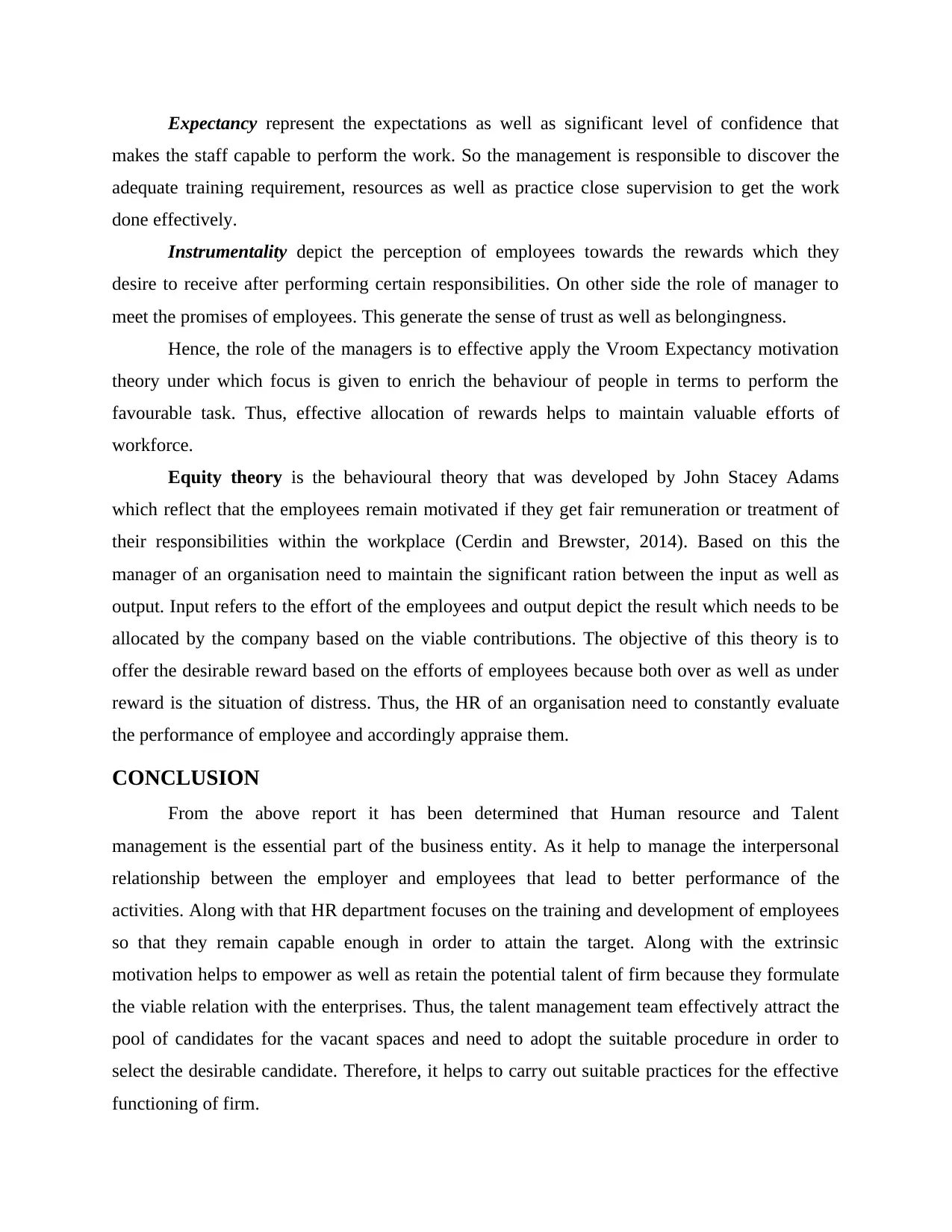
Expectancy represent the expectations as well as significant level of confidence that
makes the staff capable to perform the work. So the management is responsible to discover the
adequate training requirement, resources as well as practice close supervision to get the work
done effectively.
Instrumentality depict the perception of employees towards the rewards which they
desire to receive after performing certain responsibilities. On other side the role of manager to
meet the promises of employees. This generate the sense of trust as well as belongingness.
Hence, the role of the managers is to effective apply the Vroom Expectancy motivation
theory under which focus is given to enrich the behaviour of people in terms to perform the
favourable task. Thus, effective allocation of rewards helps to maintain valuable efforts of
workforce.
Equity theory is the behavioural theory that was developed by John Stacey Adams
which reflect that the employees remain motivated if they get fair remuneration or treatment of
their responsibilities within the workplace (Cerdin and Brewster, 2014). Based on this the
manager of an organisation need to maintain the significant ration between the input as well as
output. Input refers to the effort of the employees and output depict the result which needs to be
allocated by the company based on the viable contributions. The objective of this theory is to
offer the desirable reward based on the efforts of employees because both over as well as under
reward is the situation of distress. Thus, the HR of an organisation need to constantly evaluate
the performance of employee and accordingly appraise them.
CONCLUSION
From the above report it has been determined that Human resource and Talent
management is the essential part of the business entity. As it help to manage the interpersonal
relationship between the employer and employees that lead to better performance of the
activities. Along with that HR department focuses on the training and development of employees
so that they remain capable enough in order to attain the target. Along with the extrinsic
motivation helps to empower as well as retain the potential talent of firm because they formulate
the viable relation with the enterprises. Thus, the talent management team effectively attract the
pool of candidates for the vacant spaces and need to adopt the suitable procedure in order to
select the desirable candidate. Therefore, it helps to carry out suitable practices for the effective
functioning of firm.
makes the staff capable to perform the work. So the management is responsible to discover the
adequate training requirement, resources as well as practice close supervision to get the work
done effectively.
Instrumentality depict the perception of employees towards the rewards which they
desire to receive after performing certain responsibilities. On other side the role of manager to
meet the promises of employees. This generate the sense of trust as well as belongingness.
Hence, the role of the managers is to effective apply the Vroom Expectancy motivation
theory under which focus is given to enrich the behaviour of people in terms to perform the
favourable task. Thus, effective allocation of rewards helps to maintain valuable efforts of
workforce.
Equity theory is the behavioural theory that was developed by John Stacey Adams
which reflect that the employees remain motivated if they get fair remuneration or treatment of
their responsibilities within the workplace (Cerdin and Brewster, 2014). Based on this the
manager of an organisation need to maintain the significant ration between the input as well as
output. Input refers to the effort of the employees and output depict the result which needs to be
allocated by the company based on the viable contributions. The objective of this theory is to
offer the desirable reward based on the efforts of employees because both over as well as under
reward is the situation of distress. Thus, the HR of an organisation need to constantly evaluate
the performance of employee and accordingly appraise them.
CONCLUSION
From the above report it has been determined that Human resource and Talent
management is the essential part of the business entity. As it help to manage the interpersonal
relationship between the employer and employees that lead to better performance of the
activities. Along with that HR department focuses on the training and development of employees
so that they remain capable enough in order to attain the target. Along with the extrinsic
motivation helps to empower as well as retain the potential talent of firm because they formulate
the viable relation with the enterprises. Thus, the talent management team effectively attract the
pool of candidates for the vacant spaces and need to adopt the suitable procedure in order to
select the desirable candidate. Therefore, it helps to carry out suitable practices for the effective
functioning of firm.
Paraphrase This Document
Need a fresh take? Get an instant paraphrase of this document with our AI Paraphraser
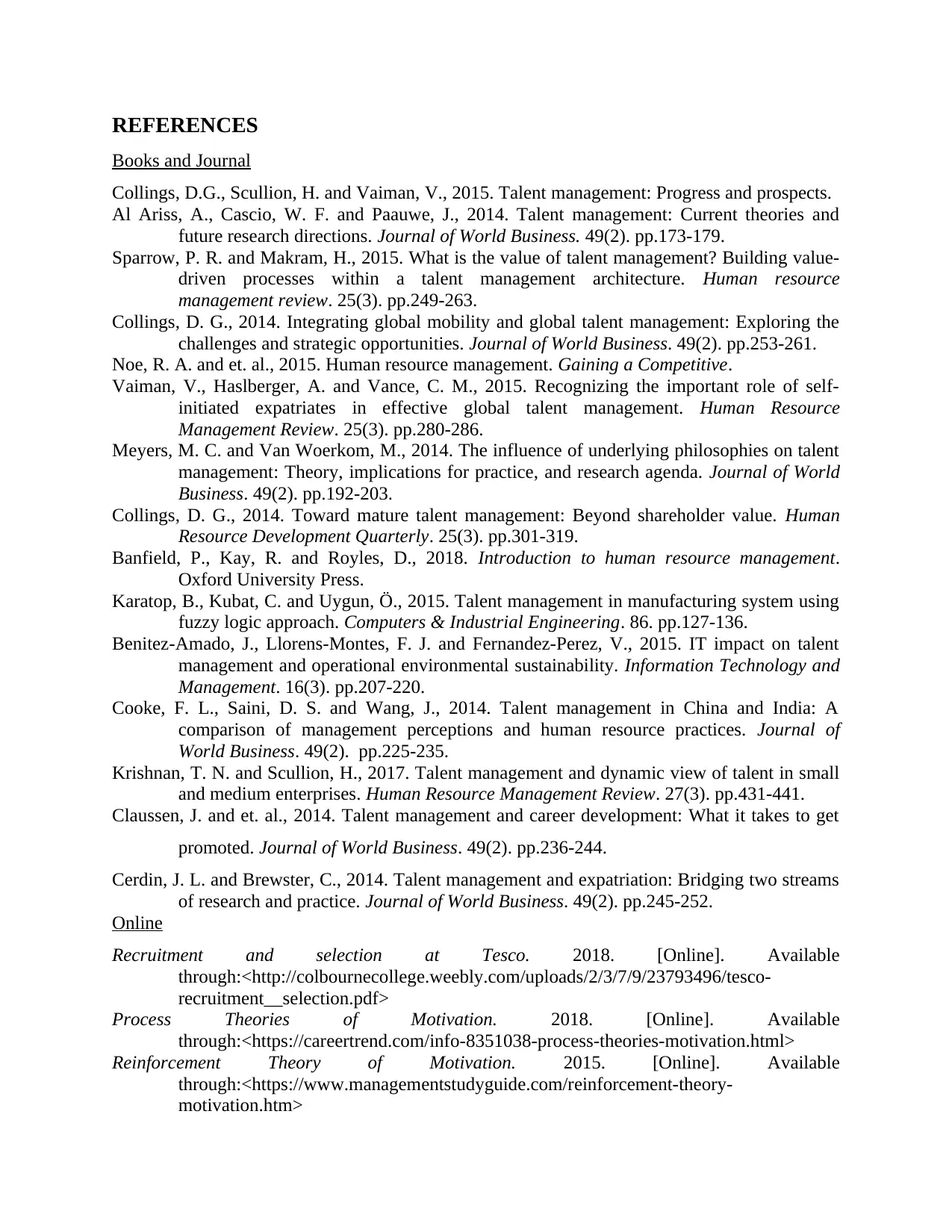
REFERENCES
Books and Journal
Collings, D.G., Scullion, H. and Vaiman, V., 2015. Talent management: Progress and prospects.
Al Ariss, A., Cascio, W. F. and Paauwe, J., 2014. Talent management: Current theories and
future research directions. Journal of World Business. 49(2). pp.173-179.
Sparrow, P. R. and Makram, H., 2015. What is the value of talent management? Building value-
driven processes within a talent management architecture. Human resource
management review. 25(3). pp.249-263.
Collings, D. G., 2014. Integrating global mobility and global talent management: Exploring the
challenges and strategic opportunities. Journal of World Business. 49(2). pp.253-261.
Noe, R. A. and et. al., 2015. Human resource management. Gaining a Competitive.
Vaiman, V., Haslberger, A. and Vance, C. M., 2015. Recognizing the important role of self-
initiated expatriates in effective global talent management. Human Resource
Management Review. 25(3). pp.280-286.
Meyers, M. C. and Van Woerkom, M., 2014. The influence of underlying philosophies on talent
management: Theory, implications for practice, and research agenda. Journal of World
Business. 49(2). pp.192-203.
Collings, D. G., 2014. Toward mature talent management: Beyond shareholder value. Human
Resource Development Quarterly. 25(3). pp.301-319.
Banfield, P., Kay, R. and Royles, D., 2018. Introduction to human resource management.
Oxford University Press.
Karatop, B., Kubat, C. and Uygun, Ö., 2015. Talent management in manufacturing system using
fuzzy logic approach. Computers & Industrial Engineering. 86. pp.127-136.
Benitez-Amado, J., Llorens-Montes, F. J. and Fernandez-Perez, V., 2015. IT impact on talent
management and operational environmental sustainability. Information Technology and
Management. 16(3). pp.207-220.
Cooke, F. L., Saini, D. S. and Wang, J., 2014. Talent management in China and India: A
comparison of management perceptions and human resource practices. Journal of
World Business. 49(2). pp.225-235.
Krishnan, T. N. and Scullion, H., 2017. Talent management and dynamic view of talent in small
and medium enterprises. Human Resource Management Review. 27(3). pp.431-441.
Claussen, J. and et. al., 2014. Talent management and career development: What it takes to get
promoted. Journal of World Business. 49(2). pp.236-244.
Cerdin, J. L. and Brewster, C., 2014. Talent management and expatriation: Bridging two streams
of research and practice. Journal of World Business. 49(2). pp.245-252.
Online
Recruitment and selection at Tesco. 2018. [Online]. Available
through:<http://colbournecollege.weebly.com/uploads/2/3/7/9/23793496/tesco-
recruitment__selection.pdf>
Process Theories of Motivation. 2018. [Online]. Available
through:<https://careertrend.com/info-8351038-process-theories-motivation.html>
Reinforcement Theory of Motivation. 2015. [Online]. Available
through:<https://www.managementstudyguide.com/reinforcement-theory-
motivation.htm>
Books and Journal
Collings, D.G., Scullion, H. and Vaiman, V., 2015. Talent management: Progress and prospects.
Al Ariss, A., Cascio, W. F. and Paauwe, J., 2014. Talent management: Current theories and
future research directions. Journal of World Business. 49(2). pp.173-179.
Sparrow, P. R. and Makram, H., 2015. What is the value of talent management? Building value-
driven processes within a talent management architecture. Human resource
management review. 25(3). pp.249-263.
Collings, D. G., 2014. Integrating global mobility and global talent management: Exploring the
challenges and strategic opportunities. Journal of World Business. 49(2). pp.253-261.
Noe, R. A. and et. al., 2015. Human resource management. Gaining a Competitive.
Vaiman, V., Haslberger, A. and Vance, C. M., 2015. Recognizing the important role of self-
initiated expatriates in effective global talent management. Human Resource
Management Review. 25(3). pp.280-286.
Meyers, M. C. and Van Woerkom, M., 2014. The influence of underlying philosophies on talent
management: Theory, implications for practice, and research agenda. Journal of World
Business. 49(2). pp.192-203.
Collings, D. G., 2014. Toward mature talent management: Beyond shareholder value. Human
Resource Development Quarterly. 25(3). pp.301-319.
Banfield, P., Kay, R. and Royles, D., 2018. Introduction to human resource management.
Oxford University Press.
Karatop, B., Kubat, C. and Uygun, Ö., 2015. Talent management in manufacturing system using
fuzzy logic approach. Computers & Industrial Engineering. 86. pp.127-136.
Benitez-Amado, J., Llorens-Montes, F. J. and Fernandez-Perez, V., 2015. IT impact on talent
management and operational environmental sustainability. Information Technology and
Management. 16(3). pp.207-220.
Cooke, F. L., Saini, D. S. and Wang, J., 2014. Talent management in China and India: A
comparison of management perceptions and human resource practices. Journal of
World Business. 49(2). pp.225-235.
Krishnan, T. N. and Scullion, H., 2017. Talent management and dynamic view of talent in small
and medium enterprises. Human Resource Management Review. 27(3). pp.431-441.
Claussen, J. and et. al., 2014. Talent management and career development: What it takes to get
promoted. Journal of World Business. 49(2). pp.236-244.
Cerdin, J. L. and Brewster, C., 2014. Talent management and expatriation: Bridging two streams
of research and practice. Journal of World Business. 49(2). pp.245-252.
Online
Recruitment and selection at Tesco. 2018. [Online]. Available
through:<http://colbournecollege.weebly.com/uploads/2/3/7/9/23793496/tesco-
recruitment__selection.pdf>
Process Theories of Motivation. 2018. [Online]. Available
through:<https://careertrend.com/info-8351038-process-theories-motivation.html>
Reinforcement Theory of Motivation. 2015. [Online]. Available
through:<https://www.managementstudyguide.com/reinforcement-theory-
motivation.htm>

⊘ This is a preview!⊘
Do you want full access?
Subscribe today to unlock all pages.

Trusted by 1+ million students worldwide
1 out of 12
Related Documents
Your All-in-One AI-Powered Toolkit for Academic Success.
+13062052269
info@desklib.com
Available 24*7 on WhatsApp / Email
![[object Object]](/_next/static/media/star-bottom.7253800d.svg)
Unlock your academic potential
Copyright © 2020–2025 A2Z Services. All Rights Reserved. Developed and managed by ZUCOL.





